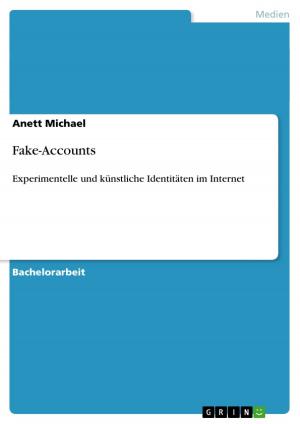Edmund Burke's Theory of the Sublime and It's Reflection in Gothic Fiction: Mary Shelley's 'Frankenstein'
Fiction & Literature, Literary Theory & Criticism, British| Author: | Alexandra Koch | ISBN: | 9783656249153 |
| Publisher: | GRIN Verlag | Publication: | July 31, 2012 |
| Imprint: | GRIN Verlag | Language: | English |
| Author: | Alexandra Koch |
| ISBN: | 9783656249153 |
| Publisher: | GRIN Verlag |
| Publication: | July 31, 2012 |
| Imprint: | GRIN Verlag |
| Language: | English |
Seminar paper from the year 2011 in the subject English Language and Literature Studies - Literature, RWTH Aachen University, language: English, abstract: Many authors would agree that Frankenstein is one of the most famous Gothic tales of all time. It was first published in 1818 and is famous for its descriptions of landscape and nature, as well as its prophetic dimension. More than 60 years before the novel was published, Edmund Burke set out to analyze the sublime. By doing so, he actually took an important step towards founding the genre Shelley engaged in, in writing Frankenstein. His A Philosophical Inquiry into the Origins of our Ideas of the Beautiful and the Sublime published in 1757 became a great success. This term paper sets out to shed light on a number of problem areas concerning the connection between Shelley's novel and Burke's theory of the sublime. The paper arose out of the Proseminar 'Gothic Literatur' by XY, M.A. in the Summer Semester 2011 at RWTH University Aachen. During the course, different topics concerning the Gothic novel were discussed in combination with four of the most famous novels belonging to the genre. Among them was Frankenstein as a novel and 'Burke's Theory of the Sublime and Its Reflection in the Gothic Fiction' as a topic. The central question to be examined in this paper is how Burke's theory of the sublime is reflected in Shelley's Gothic novel. Further questions to be dealt with in this term paper are: what is the Burkean sublime? What was new and different about Burke's concept of the Sublime - as the Sublime itself is by no means a groundbreaking, new concept. Does Shelley intentionally incorporate sublime features in her novel or comment on the use of Burke's theory? Is there a social dimension to Burke's theory? In what way does the novel reflect the sublime? Is a sense of the sublime only conveyed through descriptions of nature? ... The first part of the term paper presents Burke's theory of the sublime, an analysis of the connection between Shelley and the sublime and an analysis of the social dimension of the sublime. The next part is going to shed light on how Frankenstein as a Gothic novel reflects elements of Burke's theory of the sublime. A fuller discussion including an analysis of all scenes displaying sublime elements would go beyond the range of the paper. In this matter only five scenes were chosen. Those scenes are significant for the plot development, as well as they help to support the line of argumentation. Eventually, a conclusion will be drawn.
Seminar paper from the year 2011 in the subject English Language and Literature Studies - Literature, RWTH Aachen University, language: English, abstract: Many authors would agree that Frankenstein is one of the most famous Gothic tales of all time. It was first published in 1818 and is famous for its descriptions of landscape and nature, as well as its prophetic dimension. More than 60 years before the novel was published, Edmund Burke set out to analyze the sublime. By doing so, he actually took an important step towards founding the genre Shelley engaged in, in writing Frankenstein. His A Philosophical Inquiry into the Origins of our Ideas of the Beautiful and the Sublime published in 1757 became a great success. This term paper sets out to shed light on a number of problem areas concerning the connection between Shelley's novel and Burke's theory of the sublime. The paper arose out of the Proseminar 'Gothic Literatur' by XY, M.A. in the Summer Semester 2011 at RWTH University Aachen. During the course, different topics concerning the Gothic novel were discussed in combination with four of the most famous novels belonging to the genre. Among them was Frankenstein as a novel and 'Burke's Theory of the Sublime and Its Reflection in the Gothic Fiction' as a topic. The central question to be examined in this paper is how Burke's theory of the sublime is reflected in Shelley's Gothic novel. Further questions to be dealt with in this term paper are: what is the Burkean sublime? What was new and different about Burke's concept of the Sublime - as the Sublime itself is by no means a groundbreaking, new concept. Does Shelley intentionally incorporate sublime features in her novel or comment on the use of Burke's theory? Is there a social dimension to Burke's theory? In what way does the novel reflect the sublime? Is a sense of the sublime only conveyed through descriptions of nature? ... The first part of the term paper presents Burke's theory of the sublime, an analysis of the connection between Shelley and the sublime and an analysis of the social dimension of the sublime. The next part is going to shed light on how Frankenstein as a Gothic novel reflects elements of Burke's theory of the sublime. A fuller discussion including an analysis of all scenes displaying sublime elements would go beyond the range of the paper. In this matter only five scenes were chosen. Those scenes are significant for the plot development, as well as they help to support the line of argumentation. Eventually, a conclusion will be drawn.















